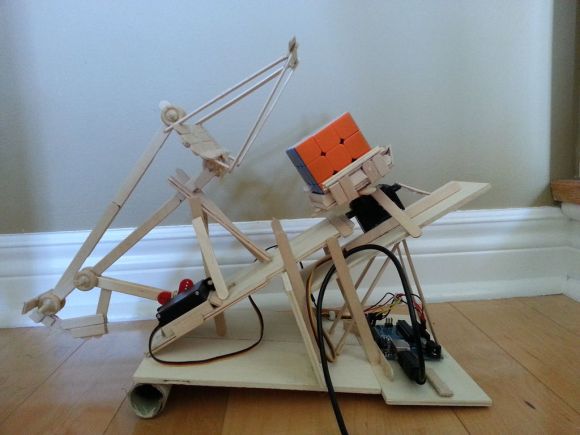
[Matt] recently learned both how to solve a Rubik’s cube and the basics of an Arduino. Putting the two together, he decided to try his hand at making an automatic Rubik’s Cube solver!
We’ve seen this done quite a few times using LEGO Mindstorms, but we’re much more impressed with [Matt’s] clever use of popsicle sticks and mechanical linkages…. The device uses just two servos. One to rotate the base, and the second to flip the cube over.
He’s using an Arduino UNO (R3) with 2 Hitec HS-311 hobby servos, some popsicle sticks, hot glue, a paper towel roll, and a bit of plywood. He wrote the code to solve the cube himself, and has shared it on GitHub — but he didn’t stop there and decided to create a GUI to go with it using Python.
It’s not that fast, but it’ll solve a cube in about 20 minutes — stick around after the break to see it in action!















I have never managed to solve it
He forgot to finish the project – slap a camera on that!
Clever. But aren’t there solutions that don’t depend on the starting state? I remember when Rubik’s cube was a “thing” (30+ ;years ago) people solving them completely sight unseen behind their backs.
I’m at a loss as to how that could possibly work.
People solve them like that by memorizing the start state and then work out the solution entirely in their head.
Exactly, they do get to see the starting state.
They memorise the state of the cube at the start and then solve it without looking. They’re not doing it completely unseen.
Do that and you will be probably rewarded with a fields medal. ;)
(ps.: y best rubik time is about 50s, quite slow, but for the algos to become faster you have to memorize many sequences and i’m too lazy)
This design funnily enough is based of a Mindstorms robot ca 2007-8.
I’m sure I’ve seen this one before. Has HAD run it in the past?
CHRIST! It’s June 28th!
Nice work.I wouldn’t know where to start if I was going to solve a rubik’s cube, either by hand or software. But I definitely think that this robot should be able to scan the cube by itself. It must be possible for instance to place 9 color-sensors on the bottom, or something like that.
Or a single one (keeping the limitations of the Arduino Uno in mind) and a way to move it or the cube or both to log start state.
The Lego one did that, with a moving Mindstorms colour sensor. I’ve done the Googling, here
http://www.youtube.com/watch?v=WG4FyoCjgdk
There’s also a website devoted to making your own, http://www.mindcuber.com/
Well, the computer is doing the solving. The popsicle sticks and Arduino just do the turning.
I worked for a guy that said he could make any jig out of Popsicle sticks. This article goes a long way towards proving he was right.